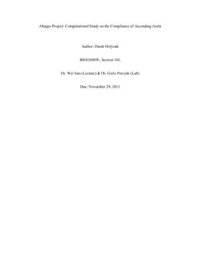
Ebook: Abaqus Project: Computational Study on the Compliance of Ascending Aorta
Author: Holyoak D.
- Genre: Medicine
- Tags: Медицинские дисциплины, Патологическая физиология
- Language: English
- pdf
BME3600W, Section 16L. — Dr. Wei Sun (Lecture) & Dr. Gielo Perczak (Lab).The human aorta is simulated.
The first step in analyzing the aortic tissue data was to determine an appropriate Young’s modulus, for both the porcine and human aortas. It was shown that because the Young’s modulus was greater for a human aorta, the inner wall of a human aorta experiences a significantly lower maximum principle stress. Furthermore, the strain in a porcine aorta is approximately four times greater than it is in a human aorta because it is more easily deformed due its lower rigidity.
Next, a human aorta under hypertension was analyzed. To account for the increased pressure on the inner wall, the aorta had to increase its thickness by approximately thirty-three percent.
Finally, the aortic aneurysm was modeled, and the results showed how much greater the stress is on the aortic wall of a person suffering from an aneurysm than it is on a normal aorta. The aneurysm causes weakening of the aortic wall, and therefore, the aorta is more prone to rupture.
All the results obtained in this project resembled real-life situations and Abaqus proved to be a very useful tool for physiological modeling.
The first step in analyzing the aortic tissue data was to determine an appropriate Young’s modulus, for both the porcine and human aortas. It was shown that because the Young’s modulus was greater for a human aorta, the inner wall of a human aorta experiences a significantly lower maximum principle stress. Furthermore, the strain in a porcine aorta is approximately four times greater than it is in a human aorta because it is more easily deformed due its lower rigidity.
Next, a human aorta under hypertension was analyzed. To account for the increased pressure on the inner wall, the aorta had to increase its thickness by approximately thirty-three percent.
Finally, the aortic aneurysm was modeled, and the results showed how much greater the stress is on the aortic wall of a person suffering from an aneurysm than it is on a normal aorta. The aneurysm causes weakening of the aortic wall, and therefore, the aorta is more prone to rupture.
All the results obtained in this project resembled real-life situations and Abaqus proved to be a very useful tool for physiological modeling.
Download the book Abaqus Project: Computational Study on the Compliance of Ascending Aorta for free or read online
Continue reading on any device:

Last viewed books
Related books
{related-news}
Comments (0)